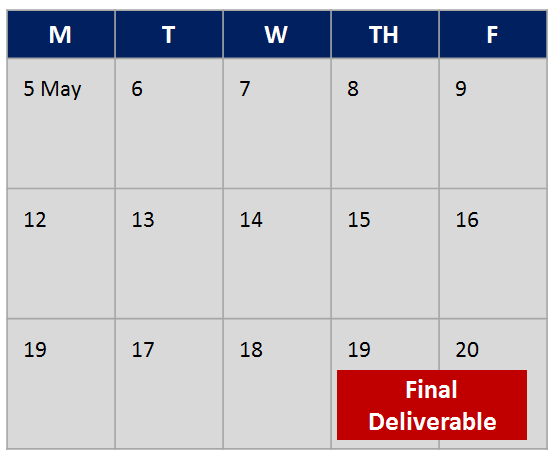What’s the deliverable?
You will hear this jargon often. A deliverable is the final product of a consulting phase or project. It comes in many forms: excel model, marketing plan, master facilities plan, workshop, customer research, or presentation. As an operations consultant, my deliverables were usually PowerPoint presentations,
It is the product, what the client is paying for

PowerPoint presentations are deliverables
This is the actual work product that we give to clients. Those pieces of paper are worth anywhere from $ 50K to $5M. Of course, clients are not fools. They know that the recommendations on those pages have the potential to generate more revenues, reduce costs, and increase cash flow. Ideally, consulting recommendations are thought-through, supported by data, actionable, and full of impact. It’s more than just the paper, or the nice looking binder. It is the expertise, research, and brain-power that supports the recommendations and findings on the 8.5″ x 11″ page (A4 if in Asia).
Presentations are mandatory
You will never find a consultant who admits they cannot put together slides or a compelling presentation. It is the currency of our work. If you cannot put together a well-structured, persuasive, and visual presentation. . . well, you won’t be a management consultant for long. It’s table stakes. Sure, clients can also pay to get business models, software interfaces, workshops, performance dashboards, training, customer surveys, knowledge management tools etc. . . but it is really the presentations that executives are used to seeing, expecting.
For example, I was recently on a project where 90%+ of the work was done in excel. The business model was beautifully laid out – full of constraints, assumptions, variables, sensitivity analysis. Each of the tabs was labeled, and color coded. Geek dream.
- Would any PowerPoint presentation do justice to the simplicity, power, and flexibility of the excel model? No.
- Did we create a PowerPoint anyway? Yes.
Why create a PowerPoint to explain the Excel?
Is this really a LEAN activity that provides value to the customer, they are willing to pay for? I would argue yes.
- Explained the process steps we took to create the excel
- Showed the people we interviewed and data sets used for the excel
- Created an instruction manual showing how the excel worked
- Highlighted the main points of the excel model
- Added graphs and sensitivity analyses (how results compared to benchmarks)
- It can be shared from executive to executive
Why PowerPoint?
Some consultants might argue with me on this, but I believe that many executives think in PowerPoint for many reasons.
- It shows logic.
- It is very visual.
- If done well, it is backed up with data.
- It’s often process-oriented, showing inputs and outputs.
- It makes assumptions explicit.
- It focuses your attention on the key takeaways.
- It’s made to communicate.
Lawyers, accountants, and marketers
Even though we have a lot of in common, your “deliverables” will be different. Less likely to be in PPT. That said, one thing you might learn from consultants. . . a simple PowerPoint, whether 3 pages or 10 pages, does provide an opportunity to summarize the project, process, and results. It is a way to discuss the work at a more strategic level. Think of it like a brief. It provides some finality to the work, and helps prevent (not avoid) scope creep.

Interesting post. We often have discussions regarding delivering results (what the client really wants) versus “deliverables” – aka, a means toward achieving the results. Hopefully. I find the best consultants are able to address both items. They can provide useful deliverables, and they don’t confuse providing a deliverable with providing results.
Amen. Completely agree, and it’s something I deal with all the time too. Sadly, seems like some of the answers are right in front of the clients’ eyes. . . and yet, they do want to see the rigor, analysis, powerpoint, and a sense that the due diligence was done.